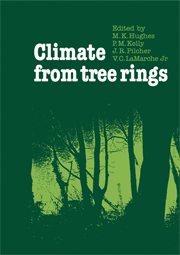2 - DATA ANALYSIS
Published online by Cambridge University Press: 05 October 2010
Summary
INTRODUCTION
The Editors
In the previous chapter, various methods of enhancing the climate signal in tree-ring chronologies have been mentioned. In order to reconstruct climate, it is necessary to extract this signal – to separate climatic factors from the many other environmental variables limiting the plant processes which control growth. The climate-growth response is complex, and reliable theoretical models have yet to be developed. Semi-empirical techniques have, therefore, been developed in order to extract the climate signal. Response functions are used to describe associations between climate data and annual ring measurements. Transfer functions are used to calibrate the ring measurements with climate data in order to provide regression equations for climate reconstruction. Both techniques employ multivariate statistical methods such as principal component or eigenvector analysis and canonical correlation and regression.
The response of the growth of trees to climate and other environmental factors is discussed by Fritts. He highlights the need for semi-empirical techniques to define and extract the macroclimatic signal from tree-ring chronologies. The response function provides an empirical method of describing the nature of the climatic factors that influence tree growth. As Hughes and Milsom point out, the response function does not measure the climategrowth response but rather the effectiveness of a particular statistical model at predicting the element of tree-ring variation forced by external factors. The response function has proved to be a valuable tool for analysing the climate-growth relationship. Guiot, Berger and Munaut review various methods of calculating response functions.
- Type
- Chapter
- Information
- Climate from Tree Rings , pp. 32 - 77Publisher: Cambridge University PressPrint publication year: 1982



